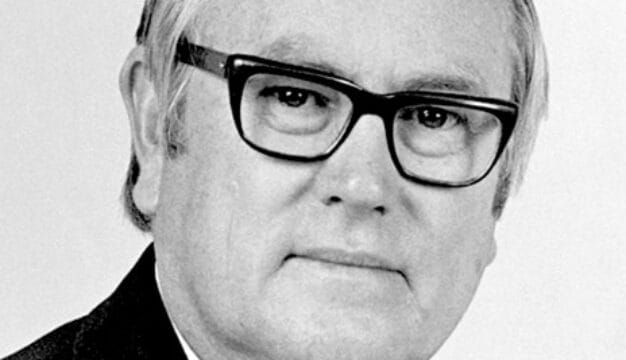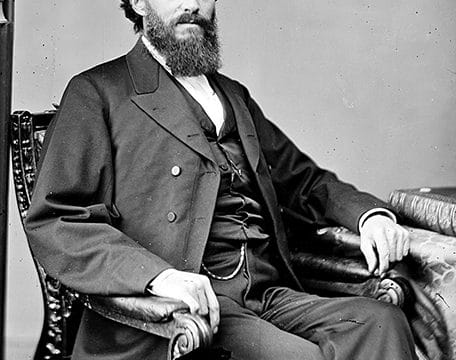Giuseppe Moretti
Giuseppe Moretti (1857-1935), an Italian-born classical sculptor, made an extraordinary impact on the state of Alabama through his design and execution of Birmingham’s 56-foot iron statue of Vulcan and his promotion of Alabama marble as a medium for fine sculpture.
 Giuseppe Moretti
Moretti was born on February 3, 1857, in Siena, Italy, and trained under master sculptors in Siena and Florence from the age of nine until seventeen. After his training, he established himself in studios in Italy; Agram (now Zagreb), Croatia; and Budapest, Hungary. Although Moretti cast many sculptures in bronze, using the lost-wax method, his favorite medium was marble, and he constantly searched for new sources of this highly workable stone. After being injured in a severe earthquake in Croatia and also losing his first wife, in 1883 Moretti applied to come to the United States for new opportunities, finally arriving in 1888. He set up a studio in New York and began accepting commissions. With artist Carl Bitter, Moretti bought a building for his studio and slowly began to prosper. Famed architect Richard Morris Hunt hired him for commissions in Newport, Rhode Island, and he received several large commissions for the Pittsburgh city park system in Pennsylvania in the 1890s. During this time, Moretti, an amateur opera singer, joined the Liederkranz music club and befriended legendary opera singer Enrico Caruso.
Giuseppe Moretti
Moretti was born on February 3, 1857, in Siena, Italy, and trained under master sculptors in Siena and Florence from the age of nine until seventeen. After his training, he established himself in studios in Italy; Agram (now Zagreb), Croatia; and Budapest, Hungary. Although Moretti cast many sculptures in bronze, using the lost-wax method, his favorite medium was marble, and he constantly searched for new sources of this highly workable stone. After being injured in a severe earthquake in Croatia and also losing his first wife, in 1883 Moretti applied to come to the United States for new opportunities, finally arriving in 1888. He set up a studio in New York and began accepting commissions. With artist Carl Bitter, Moretti bought a building for his studio and slowly began to prosper. Famed architect Richard Morris Hunt hired him for commissions in Newport, Rhode Island, and he received several large commissions for the Pittsburgh city park system in Pennsylvania in the 1890s. During this time, Moretti, an amateur opera singer, joined the Liederkranz music club and befriended legendary opera singer Enrico Caruso.
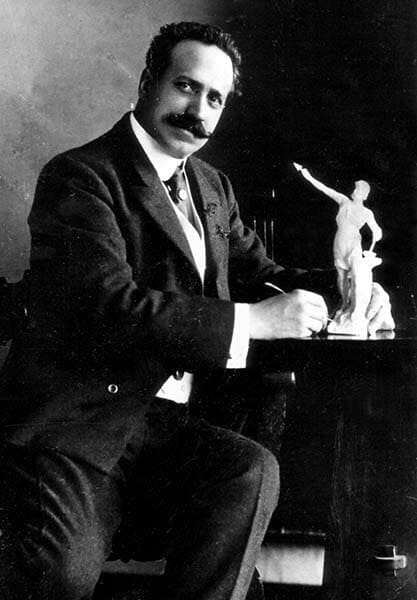 Giuseppe Moretti
In 1903, the Commercial Club of Birmingham (forerunner of the Birmingham Chamber of Commerce) sought out Moretti to sculpt a statue of Vulcan, the Roman god of fire and metalworking, as a symbol of Birmingham’s origins in the iron and steel industry. The statue would represent the state at the 1904 World’s Fair, held in St. Louis, Missouri, in honor of the centennial celebration of the Louisiana Purchase. Moretti accepted the challenge to create a 56-foot statue of iron in a few short months. He completed a clay model of the statue in New Jersey and came to Birmingham to oversee the casting. While in Alabama, he visited the marble quarries around Sylacauga, camping out in the woods with Alabama industrialist John Adams, and discovered that Alabama marble was of outstanding quality. Moretti decided to find a way to buy land and establish his own quarry in Alabama. He hauled a sample block of the gleaming white stone back to his studio in Birmingham and carved The Head of Christ, a work that he carried with him to every place that he lived for the rest of his life. (It is now on display at the Alabama Department of Archives and History.)
Giuseppe Moretti
In 1903, the Commercial Club of Birmingham (forerunner of the Birmingham Chamber of Commerce) sought out Moretti to sculpt a statue of Vulcan, the Roman god of fire and metalworking, as a symbol of Birmingham’s origins in the iron and steel industry. The statue would represent the state at the 1904 World’s Fair, held in St. Louis, Missouri, in honor of the centennial celebration of the Louisiana Purchase. Moretti accepted the challenge to create a 56-foot statue of iron in a few short months. He completed a clay model of the statue in New Jersey and came to Birmingham to oversee the casting. While in Alabama, he visited the marble quarries around Sylacauga, camping out in the woods with Alabama industrialist John Adams, and discovered that Alabama marble was of outstanding quality. Moretti decided to find a way to buy land and establish his own quarry in Alabama. He hauled a sample block of the gleaming white stone back to his studio in Birmingham and carved The Head of Christ, a work that he carried with him to every place that he lived for the rest of his life. (It is now on display at the Alabama Department of Archives and History.)
In 1905, Henry M. Atkinson and P. S. Arkwright, who founded the Atlanta, Birmingham, and Atlantic (AB&A) Railroad, agreed to invest with Moretti in the Alabama marble quarries. Moretti closed his studio in New York and moved to Talladega County, building a large home that he called Monte Pino, or Pine Mountain, near the quarries. At the time that Moretti began mining Alabama marble, $5 million worth of architectural marble was being imported from Italy into the United States each year. Moretti’s dream was to have Alabama marble replace imported Italian marble. To show the translucence and superior quality of the marble to potential buyers, Moretti cut a piece nine feet long and only one-eighth inch thick and also carved a number of small marble sculptures of a female figure in front of a lyre, which he titled Music, to showcase the stone. After the quarry opened, Moretti lured other Italian artisans to work with him in Talladega County.
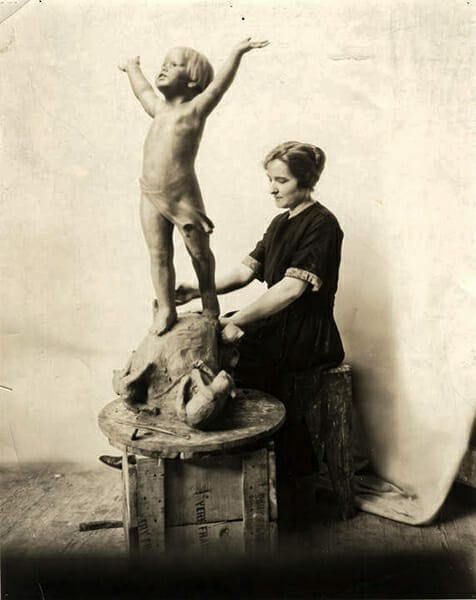 Geneva Mercer
Also in 1905, Moretti married Dorothea Long, a member of an aristocratic Boston family, in her hometown of Brookline, Massachusetts. Twelve years his junior, Long moved into a new world of steam shovels and southern culture. An intelligent and articulate woman, Dorothea wrote Moretti’s correspondence and kept his accounting books. In 1907, Moretti encountered the work of Geneva Mercer, a young woman from Marengo County who was studying at Livingston Female Academy (now the University of West Alabama), in Sumter County. Education reformer Julia Tutwiler, who taught at the school, saw the potential in Mercer’s sculptures and took them to Birmingham to display at the Commercial Club. Moretti saw the sculptures, recognized Mercer’s talent, and asked her if she would intern at his studio. The internship became a lifelong commitment, and Mercer would live with the couple until their deaths. Mercer learned to create models in clay and to cast sculptures in bronze, but she never worked in marble.
Geneva Mercer
Also in 1905, Moretti married Dorothea Long, a member of an aristocratic Boston family, in her hometown of Brookline, Massachusetts. Twelve years his junior, Long moved into a new world of steam shovels and southern culture. An intelligent and articulate woman, Dorothea wrote Moretti’s correspondence and kept his accounting books. In 1907, Moretti encountered the work of Geneva Mercer, a young woman from Marengo County who was studying at Livingston Female Academy (now the University of West Alabama), in Sumter County. Education reformer Julia Tutwiler, who taught at the school, saw the potential in Mercer’s sculptures and took them to Birmingham to display at the Commercial Club. Moretti saw the sculptures, recognized Mercer’s talent, and asked her if she would intern at his studio. The internship became a lifelong commitment, and Mercer would live with the couple until their deaths. Mercer learned to create models in clay and to cast sculptures in bronze, but she never worked in marble.
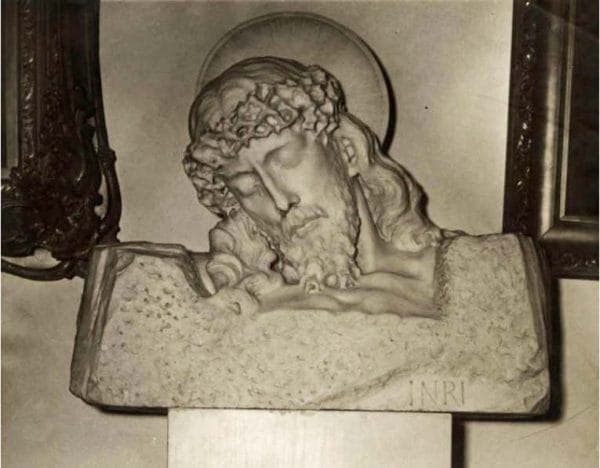 Head of Christ
In 1909, Moretti’s investment partners and the AB&A Railroad went bankrupt, and he lost his quarries and his home and had to return to making a living solely with his sculptural commissions. He, Dorothea, and Geneva left Alabama, and during the next 13 years lived in New York City; Florence, Italy; Havana, Cuba; and Pittsburgh, Pennsylvania. One of his great achievements during this period was to complete, with Mercer’s help, 97 sculptures for the Gran Teatro de la Habana in Cuba. The Morettis and Mercer returned briefly to Alabama in the early 1920s, and he built a two-story home and a studio near his beloved quarries in Talladega County. Because of a shortage of experienced casters and artisans, his own lack of business acumen, and his advancing age, Moretti reluctantly decided to return to Italy, where labor and artisans were plentiful.
Head of Christ
In 1909, Moretti’s investment partners and the AB&A Railroad went bankrupt, and he lost his quarries and his home and had to return to making a living solely with his sculptural commissions. He, Dorothea, and Geneva left Alabama, and during the next 13 years lived in New York City; Florence, Italy; Havana, Cuba; and Pittsburgh, Pennsylvania. One of his great achievements during this period was to complete, with Mercer’s help, 97 sculptures for the Gran Teatro de la Habana in Cuba. The Morettis and Mercer returned briefly to Alabama in the early 1920s, and he built a two-story home and a studio near his beloved quarries in Talladega County. Because of a shortage of experienced casters and artisans, his own lack of business acumen, and his advancing age, Moretti reluctantly decided to return to Italy, where labor and artisans were plentiful.
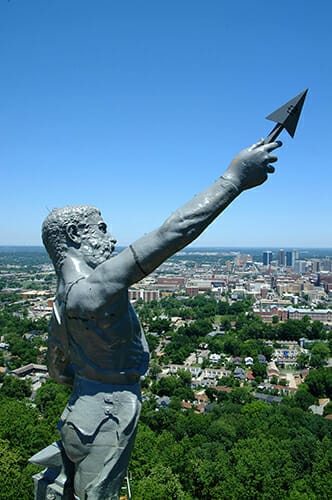 Statue of Vulcan
Back in Italy, the Morettis and Mercer occupied a large villa and studio in San Remo. Moretti and Mercer set about completing three major commissions: the Governor Brown Memorial for the city of Atlanta, Georgia; a monument for the Battle of Nashville, commissioned by friends from Nashville, Tennessee; and the Patterson Memorial, commissioned to honor John H. Patterson, the founder of the National Cash Register Company. In the early 1930s, Moretti was diagnosed with prostate cancer. As his health failed, he worked on smaller pieces and wrote poetry. He died in February 1935 and was buried in San Remo.
Statue of Vulcan
Back in Italy, the Morettis and Mercer occupied a large villa and studio in San Remo. Moretti and Mercer set about completing three major commissions: the Governor Brown Memorial for the city of Atlanta, Georgia; a monument for the Battle of Nashville, commissioned by friends from Nashville, Tennessee; and the Patterson Memorial, commissioned to honor John H. Patterson, the founder of the National Cash Register Company. In the early 1930s, Moretti was diagnosed with prostate cancer. As his health failed, he worked on smaller pieces and wrote poetry. He died in February 1935 and was buried in San Remo.
Before he died, Giuseppe Moretti related to Geneva Mercer that one of his greatest achievements was his discovery and promotion of beautiful Alabama marble. During his lifetime, he established at least 10 companies for the quarrying, sale, and distribution of white and blue marble from Talladega County. After Moretti’s discovery of Alabama marble, he carried the beautiful stone with him wherever he lived; he used it in his homes and sculpted creations from it until his death. Marble from the Sylacauga area continues to be an important resource and export for the state.
Additional Resources
Cason, Bob. “Moretti’s Warning: The Myth Demystified.” Alabama Heritage 73 (Summer 2004): 38-40.
Fowler, Miriam Rogers, ed. Giuseppe Moretti Master Sculptor and Father of Vulcan. Exhibition Catalogue. Birmingham, Ala.: Birmingham Museum of Art, 2002.
———. “Giuseppe Moretti: Master Sculptor.” American Art Review 16 (December 2002): 142-49; 175.
Giuseppe Moretti Collection, Birmingham Archives, Birmingham Public Library, Main Branch, Birmingham, Alabama.
Geneva Mercer Papers, Birmingham Archives, Birmingham Public Library, Main Branch, Birmingham, Alabama.
Geneva Mercer Scrapbooks, Alabama Room, Julia Tutwiler Library Archives, University of West Alabama, Livingston, Alabama.
Whiting, Marvin Y., ed. “Giuseppe Moretti.” Journal of the Birmingham Historical Society 9 (December 1985): 5-13; 60.

